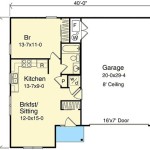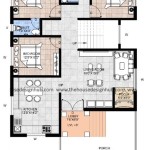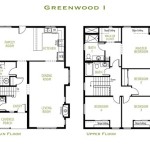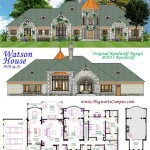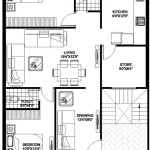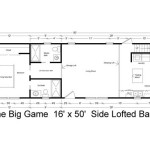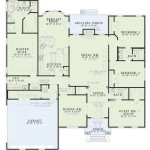One-Story Colonial Home Plans: A Comprehensive Overview
The Colonial home, a staple of American architectural history, traditionally presents as a two-story dwelling with a symmetrical facade and a centrally located front door. However, the one-story Colonial, also known as a Ranch Colonial or a Rambler Colonial, offers a unique and accessible interpretation of this timeless style. These designs retain the charm and elegance of the Colonial aesthetic while providing the convenience and accessibility of single-level living. This article will delve into the intricacies of one-story Colonial home plans, exploring their defining features, benefits, design considerations, and various adaptations.
The appeal of a one-story Colonial home lies in its ability to blend the classic architectural elements of the Colonial style with the practical advantages of single-story construction. This makes it an attractive option for a diverse range of homeowners, including those seeking aging-in-place solutions, families with young children, and individuals who simply prefer the ease and convenience of a single-level layout. Understanding the nuances of these plans is crucial for anyone considering building or renovating a home in this style.
Key Characteristics of One-Story Colonial Homes
One-story Colonial homes strive to capture the essence of traditional Colonial architecture while adhering to a single-level format. Several key characteristics define this particular style:
Symmetrical Facade: Symmetry is a cornerstone of Colonial design, and this principle extends to one-story adaptations. The front facade typically features a balanced arrangement of windows and a centrally positioned front door. This creates a visually pleasing and orderly appearance.
Rectangular Shape: Most one-story Colonial homes maintain a rectangular or slightly elongated rectangular footprint. This contributes to the overall symmetry and provides a practical and efficient layout for interior spaces.
Low-Pitched Roof: While traditional Colonial homes often boast steeper rooflines, one-story versions typically feature a lower pitched roof. This helps to maintain a proportionate appearance and avoids overwhelming the single-story structure. The roof is often a gable style, sometimes with dormers added for visual interest and increased attic space.
Traditional Window Styles: Double-hung windows are a common feature, often adorned with shutters. The windows are typically arranged symmetrically across the front facade, further emphasizing the balanced design.
Simple Exterior Detailing: While ornamentation is usually more restrained than in other Colonial variations, one-story Colonial homes often incorporate simple details such as dentil molding under the eaves, decorative door surrounds, and understated window trim. Siding is typically clapboard or brick, reflecting the materials historically associated with Colonial architecture.
Covered Entryway: A covered porch or portico is a frequent addition to one-story Colonial homes, providing shelter and enhancing the entry's visual appeal. The porch supports are often simple columns or posts, consistent with the overall design aesthetic.
Benefits of Choosing a One-Story Colonial Home Plan
Selecting a one-story Colonial home plan offers numerous advantages over multi-story alternatives. These benefits cater to a wide range of lifestyle needs and preferences:
Accessibility and Aging-in-Place: Perhaps the most significant benefit is the accessibility provided by a single-level layout. This eliminates the need for stairs, making the home suitable for individuals with mobility limitations, young children, and those planning to age in place. This design caters to homeowners who prioritize long-term livability and independence.
Ease of Maintenance: With all living spaces located on one level, maintenance becomes significantly easier. Tasks such as cleaning, painting, and repairs are streamlined without the challenges posed by stairs and multiple levels. Exterior maintenance, such as gutter cleaning, is also simplified.
Improved Safety: The absence of stairs reduces the risk of falls, contributing to a safer living environment, especially for families with young children or elderly individuals. This is a critical consideration for homeowners prioritizing safety and well-being.
Open Concept Living: One-story layouts often lend themselves to open-concept living spaces, fostering a sense of connection and facilitating social interaction. This design approach is popular for contemporary lifestyles, allowing for seamless flow between living, dining, and kitchen areas.
Simplified Construction: In general, one-story homes are typically easier and less expensive to build than multi-story homes. The simpler structural design reduces the complexity of the construction process, potentially leading to cost savings and faster completion times.
Energy Efficiency: Single-story homes can be more energy-efficient due to their compact design and reduced surface area exposed to the elements. This can translate to lower heating and cooling costs, contributing to long-term savings and environmental sustainability.
Design Considerations for One-Story Colonial Home Plans
Careful planning is essential when designing a one-story Colonial home. Several key considerations must be taken into account to maximize functionality and aesthetic appeal:
Lot Size and Orientation: The size and shape of the building lot will influence the overall design of the home. A wider lot is generally preferred for one-story layouts, allowing for a more expansive floor plan and better natural light exposure. The orientation of the home on the lot should be carefully considered to optimize sunlight and ventilation.
Floor Plan Layout: The floor plan needs to be thoughtfully designed to maximize space utilization and ensure a comfortable flow between rooms. Consider separating living areas from sleeping areas to provide privacy and minimize noise transmission. The placement of bathrooms, kitchens, and laundry rooms should be strategically planned for convenience and efficiency.
Natural Light: Maximizing natural light is crucial for creating a bright and inviting living space. Large windows, skylights, and strategically placed doors can help to flood the home with natural light. Consider the orientation of the windows to capture sunlight throughout the day. The use of light colors for walls and ceilings can also enhance brightness.
Storage Space: Ample storage space is essential in any home, but it is particularly important in a one-story layout where vertical space is limited. Consider incorporating built-in storage solutions, such as closets, cabinets, and shelving, throughout the home. Attic space, if available, can also be utilized for storage. Garages and external storage sheds can also provide valuable storage options.
Accessibility Features: If accessibility is a primary concern, it is important to incorporate universal design principles into the home's design. This may include wider doorways, roll-in showers, grab bars, and lever-style door handles. Ramps can be used to provide access to entrances and other areas of the home.
Exterior Design Elements: Maintaining the Colonial aesthetic is crucial in a one-story adaptation. Pay attention to exterior details such as siding material, window style, roof pitch, and front porch design. Consider incorporating traditional Colonial elements such as shutters, dentil molding, and a symmetrical facade.
HVAC System Design: Careful design of the heating, ventilation, and air conditioning (HVAC) system is important for ensuring efficient and comfortable climate control throughout the home. Consider using a zoned HVAC system to allow for independent temperature control in different areas of the house. Properly insulated walls and ceilings can also help to reduce energy consumption.
Landscaping: Thoughtful landscaping can enhance the curb appeal of a one-story Colonial home and create a welcoming outdoor space. Consider incorporating traditional Colonial landscaping elements such as symmetrical planting beds, boxwood hedges, and a well-manicured lawn. A brick or stone walkway leading to the front door can also add to the overall aesthetic.
By giving adequate attention to all these crucial points, you can create a one-story Colonial home that is both aesthetically pleasing and extremely practical.

1916 Single Story Modern Colonial Ladies Home Journal Walter Swindell Davis House Plans Sims How To Plan

Colonial House Plans Southern Floor

Plan 042h 0021 The House

Image Result For One Story Colonial Homes Style House Plans

Colonial Style House Plan 5 Beds 3 Baths 2705 Sq Ft 275 Eplans Com

House Plan 62072 Southern Style With 2603 Sq Ft 4 Bed 2 Bath

Plan 41463 Louisiana Style Home With 3 Car Garage And Outd

Stylish One Story House Plans Blog Eplans Com

Spanish Colonial Home Plans Sater Design Collection

Dream Single Story House Plans Customizable One Homes


